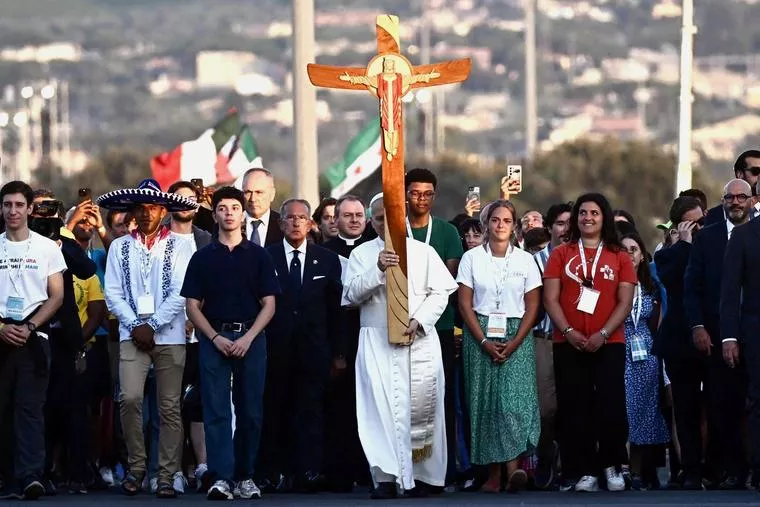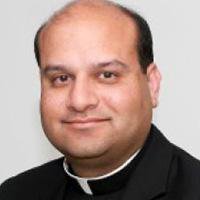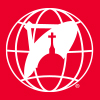
COMMENTARY: Starting with Pope St. John Paul II and World Youth Day, recent popes have had their pontificates ‘baptized’ by rallies connected to Catholic youth.
SIGN UP FOR OUR NEWSLETTER HERE
Once may be happenstance, twice good fortune, but thrice is Providence.
Pope Leo XIV’s triumph at the Jubilee for Youth earlier this month made him the third consecutive pope to have his pontificate “baptized” in the legacy of Pope St. John Paul II.
When John Paul died in April 2005, the massive influx of young people into Rome — sleeping overnight in the streets, singing spontaneously during the long hours queuing to pray before his mortal remains, converting doorways and side streets into makeshift confessionals — was considered by some longtime papal observers as the final World Youth Day of his historic pontificate.
It had been 20 years exactly since the first World Youth Day in Rome in 1985, and even as John Paul aged, he maintained his intimate connection with youth. The “final WYD” of 2005 began with words from the papal deathbed. Told of the immense number of young people attending him in his final hours, the dying Holy Father whispered a message for them: “I have looked for you. Now you have come to me. And I thank you.”
Thus, when the cardinals gathered to elect his successor, a consideration was whether any candidate could take up the banner of World Youth Day. Was there any in their number who could do what John Paul did?
The answer to that was definitively No, but the question was wrong. It was not the new pope who would have to hold up WYD, but WYD that would hold up the new pope.
WYD was not only a gift from John Paul to the youth of the world, but a gift to his successors, affording them a ready opportunity to introduce themselves to the world in a fulsome celebration of the Catholic faith, of friendship with Christ and the joy of the gospel. John Paul left the legacy; Providence appointed that his successors would be buoyed up by it at the outset of their pontificates.
Pope Benedict XVI immediately understood that. He declared that “the Church is young,” “the Church is alive” in his inaugural homily, something everyone in Rome had just seen with their own eyes. He addressed his moving words to the young people so beloved by John Paul.
WYD 2005 was just months away in Cologne, Germany. Would the German Pope choose that for his first foreign trip, his first trip home? Or would the bookish professor opt for something, well, less Johannine-Pauline?
Benedict dispelled worries on that front quickly, telling Cardinal Joachim Meisner of Cologne in the early days that he would see him in Cologne. Any fears that Benedict could not handle the public dimension of the papacy evaporated in Cologne.
The Holy Father did not go to Germany as a clone of John Paul; he made WYD his own, introducing Eucharistic adoration into the vigil program. It has remained ever since. Many pilgrims speak of the inspiring witness of hundreds of thousands, even more than a million, young people in silent prayer before the monstrance as their dominant memory of WYD.
Eight years later, so important did Benedict consider the pope’s presence at WYD that it was one reason he abdicated in February 2013. He had concluded that he did not have the physical strength to make the trip that summer to Rio de Janeiro, Brazil. It then fell to his successor, Pope Francis, to begin his papacy with his first foreign trip at WYD.
The late Holy Father made the Rio WYD his own, too, while keeping the traditions of both John Paul and Benedict. It was in Rio that he exhorted the youth of Argentina to “make a mess,” and it was on the flight home that he began his airborne press conferences with the signature phrase of his pontificate: “Who am I to judge?”
Pope Leo XIV has not yet traveled abroad, but the current Jubilee year has brought pilgrims from all over the world to him. The Jubilee for Youth was considered a mini-WYD, and Leo repeatedly evoked the memories of WYD Rome 2000, which took place in the context of the Great Jubilee that year.
Leo quoted John Paul’s theme for WYD 2002 in Toronto when he spoke off the cuff to young people in St. Peter’s Square after his surprise popemobile ride: “You are the salt of the earth; you are the light of the world.”
And in his formal addresses, he returned to John Paul’s most memorable words a quarter-century earlier in the same place:
“It is Jesus in fact that you seek when you dream of happiness; he is waiting for you when nothing else you find satisfies you; he is the beauty to which you are so attracted; it is he who provokes you with that thirst for fullness that will not let you settle for compromise; it is he who urges you to shed the masks of a false life; it is he who reads in your hearts your most genuine choices, the choices that others try to stifle.
“It is Jesus who stirs in you the desire to do something great with your lives, the will to follow an ideal, the refusal to allow yourselves to be grounded down by mediocrity, the courage to commit yourselves humbly and patiently to improving yourselves and society, making the world more human and more fraternal.”
Leo was careful to quote from Benedict and Francis, too, using the youth gathering to illustrate continuity with his three predecessors.
In its fourth pontificate, WYD has now become a permanent part of the 21st-century papacy. Apart from the Holy Father’s liturgical obligations, it is hard to think of anything that would be more difficult to eliminate from the papal calendar.
The now institutional link between the pope — whoever he may be — and young people grants the Church a voice precisely among those who are thought to be, and often are, most distant from the things of God. WYD means that each pope has a privileged opportunity to speak to the ideals and aspirations of the young — and through them to all generations — with the good news of the gospel, and the gift of salvation in Jesus Christ. That he does so amid some of the largest gatherings on the planet means the world pays some attention.
That each of the last three popes was able to do that in the first months of his pontificate suggests that something more than John Paul’s pastoral vision is at work. Three times is Providence.
This article was originally published on National Catholic Register.

Father Raymond J. de Souza is the founding editor of Convivium magazine.







